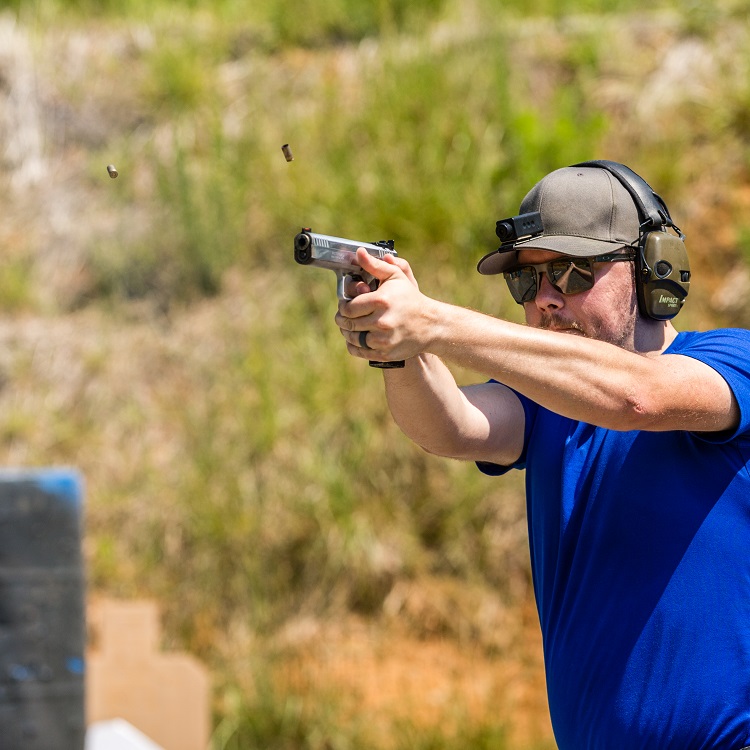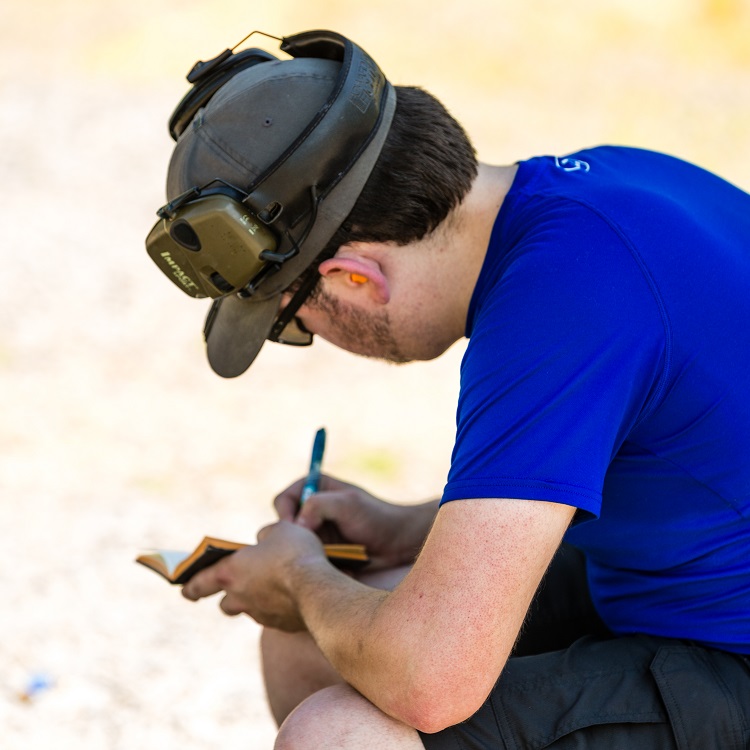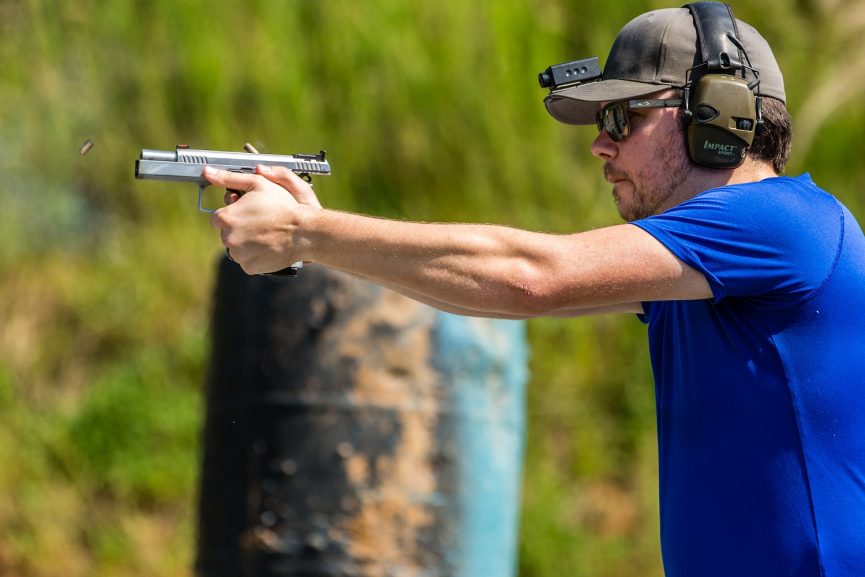This summer, one of the changes I’m making to my practice is to live fire at least one evening a week. Last year, I would live fire every weekend I wasn’t shooting a match, which was two practice sessions most months. This new schedule gives me four a month, with as many as six if I go on the weekends. This is much more in line with the typical practice schedule for someone who wants to be competitive at the GM level.
The First Practice
Last Friday, June 22nd, was the second week of this new routine. It had been a tiring day at work, and I didn’t feel motivated or energized to go. But I went anyway because, well, that’s the new routine.
What made things interesting about this particular practice is that it also worked out for me to be back on the range practicing again the very next day as well, since there was a USPSA RO class going on at the range. I volunteered to help the NC Section Coordinator (who I’m married to) by picking up lunch and bringing it to the class.
But Friday’s practice did not go particularly well. I started the session by shooting a variant of Practical Accuracy that I’d shot in sessions past, and just trying to deliver the same performance that I’d had in the past. Just reproduce that performance, my plan went, and then move on to working on new skills.
But I couldn’t do it. I spent all 400 rounds just trying to figure out what I was doing wrong on this one drill. I never really made any progress. I figured out a few small things, but never did achieve the standard I started out the session trying to hit. I was so worn down that I didn’t have any creativity left to figure out the problem. So I shot my rounds and went home.
That evening, I spent an hour or so writing my first post on PSTG about this experience, in a sort of long, rambling, impromptu range diary. I think I just needed to blow off some steam about the experience and thought it would be interesting to get things in writing, as a snapshot before the practice the next day.

The Second Practice
And so Saturday’s practice came. It was slightly better, but only because I gave up. After 200 rounds on the same drill from Friday I was frustrated. I was trying everything I could think of and getting bad hits on the target and slow times. In retrospect, the way I would phrase it is that the harder I tried to make the technique changes the worse the result got. Putting it like that makes it clear the solution was to stop and do something else, but in the moment I didn’t think about it like that.
So instead of just packing up and going home or spending the rest of the session stuck in this rut, I moved on to my planned second drill of the day. I set up an 8-shot mini-stage and started to shoot it. Even there, I was frustrated with the results. The harder I tried, the worse the results. I diagnosed a few small things that were going wrong with my technique and really shifted around my grip pressure on the gun, this time making a real emphasis to crush with my left hand and leave my right hand loose enough to run the trigger straight back. At the very end of the session I started to see some gains from that.
So when I got home, I wrote another, equally long follow up post in the PSTG thread. I had gotten my thoughts off my chest, and writing the post, like writing these blog posts, helped me try to organize my thoughts. So, I wasn’t really expecting anything to happen after the second post, but I got a few interesting responses.
Two very good shooters, Cody Axon (of the Shoot Fast Podcast) and Tyler Turner (occasional guest on Practical Shooting After Dark) both chimed in with essentially the same message: Stop overthinking things. Stop analyzing things to death. Stop trying to make judgements and adjustments after every run. Stop shooting so many pass/fail, objective-standards drills.
Just go shoot, they told me. Set up some targets and shoot them and just see what happens. Observe yourself shooting.
For example, one bad habit I had developed was trying to score the targets between runs. For efficiency, I had adopted the common practice of shooting a given drill 4 or 5 times between going downrange to paste. The advantage of this is that you can get in a groove and shoot a few runs back to back to feel the small differences between them, as well as just saving you a lot of time and energy. But I would try to look for holes on the target between runs. If I saw a delta or mike, I might consciously change my focus on the next iteration of the drill.
This, of course, was defeating the point. Instead of shooting five runs in the same mindset and then seeing a sort of “average” performance on the targets, I was constantly trying to course correct between reps, and so the multiple runs overlaid on each other were just a confusing mixture of multiple different approaches to the drill.
The antidote, they helped me realize, is to give up on wanting to know the result of every single shot. Stop looking so close at trees and try to see the shape of the forest.

The Third Practice
Taking that attitude into evening practice this past week really made a difference. The hardest part was forcing myself not to look at the targets between runs. When I was done shooting, I would deliberately keep my eyes looking down at the ground or focused at front sight distance so I wasn’t looking for holes on the first target.
One obvious-in-hindsight side effect of this was that it made me call my shots more. Since I wasn’t looking at the targets after every run, I had to actually watch the sights and notice what they were doing if I wanted to have an idea of where the hits went from one run to another. I didn’t realize the extent to which looking at the hits after each rep was becoming a crutch to let me shoot without really seeing my sights and just hoping the hits were there.
The second side effect of this was that practice was just more enjoyable and productive. Instead of constantly changing things and flailing around, by shooting multiple runs and making smaller tweaks in between, I was counter-intuitively able to make more progress in a single session than I had in a long time. I got in a groove, shot well, and made small, incremental gains.
The First Match
And so, this weekend, a week and a half after that first forum post, I shot my first match with the “Just Go Shoot” mindset.
One mental shift that carried over almost directly from practice to the match was changing the way I evaluated my performance on each stage. I used to look at each individual stage as an independent event. After I shot each stage, I would sit down and write notes in a little notebook about what went well and what went poorly.

My goal of taking notes was always to gather and preserve the data for later analysis, but I found I actually rarely ended up going back to the notebook and referring to it. Instead, all I was doing was prematurely judging the results of a particular target or position as good or bad and trying to speculate on the cause. Shot high right on third target in the first position, due to overtransitioning. Fumbled reload because distracted looking for holes in last target. That sort of thing.
Instead, I reserved judgement and just tried to observe patterns and trends throughout the day. And I think doing that managed to making the match both more enjoyable and more productive. I learned a few things and noticed a few patterns. I’ll admit, probably fewer things than if I had tried to make thorough notes. But you can only hold a few priorities in your head at a time anyway. Trying to turn every stage of every match into thorough study of all the flaws in my shooting was, to borrow a word from Tyler, exhausting.
It was also vulnerable to being distracted by one-off freak events. Often times I would remember the single oddest events all day, which are usually the least statistically representative of my actual skill. Instead of seeing the subtle pattern re-appearing on three or four stages, I would end up paying attention to the weird thing that happened on just one stage, which was a complete distraction. Focusing on it and chasing it would of course be a wild goose chase. Exhausting.
So I went to the match. I got my video, but I didn’t take any notes. But somehow despite not having written anything down, I have clear mental pictures of the three biggest fish to fry coming out of the match. And so I can work on them. I spent less time sitting and writing, and kept more of an open mind. I spent less time dwelling on errors and trying to diagnose and judge them in the moment, and more time just enjoying being out shooting.
Going Forward
One of the other common themes from what Cody and Tyler told me, which gels with previous conversations I’ve had with Cody and others is: don’t work so hard. This is supposed to be fun. Sure you won’t always be excited to do it every single day, but in general the idea of investing time in the sport should be appealing, in a way that it really hadn’t been for a while.
With their help and the video resources on PSTG, I feel like the fun is back. Nationals is still four months away. I feel like I’ve made some technique breakthroughs on grip, as well as process breakthroughs about practicing during the week, not to mention the mental breakthrough of “Just Go Shoot”. It’s going to be a good season.
All photos in this post courtesy of Bradley, aka @trigger_pull.

